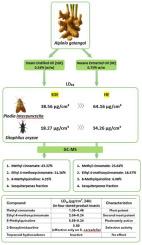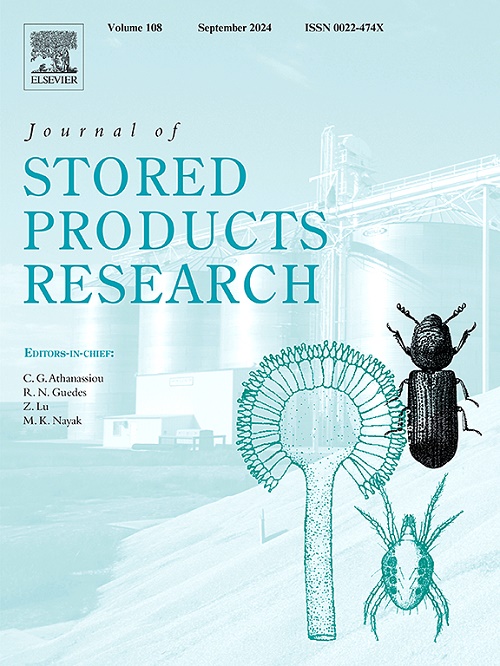苯丙酸酯,特别是肉桂酸甲酯和4-甲氧基肉桂酸乙酯,驱动高良姜根油对储存产品昆虫的杀虫潜力
IF 2.7
2区 农林科学
Q1 ENTOMOLOGY
引用次数: 0
摘要
寻求在气相中有效起作用的植物选择,以最小的残留物进行采后保护。我们比较了从高良姜根中提取的富含酯的蒸汽蒸馏萃取(SDE)油和己烷萃取物(HE),通过气相色谱-质谱分析了它们的化学性质,并在标准化生物测定下定量了对四种主要储存品害虫的熏蒸和接触毒性。不同物种间,SDE的熏蒸效果均优于HE: SDE对点间倍蝇幼虫的LD50 (μg/cm3)分别为38.56、33.64、18.27和21.47,且其熏蒸效果较陡,模型拟合较好;相应的HE LD50值较高,分别为64.16、52.31、34.26、42.96 μg/cm3。接触生物测定的LD50 (μg/cm2)分别为:点间稻蠹蛾幼虫43.46、谷类稻蠹蛾成虫39.57、米螟稻蠹蛾25.02、玉米螟30.63。肉桂酸甲酯(43.32%)和4-甲氧基肉桂酸乙酯(31.36%)相对于he相关的挥发性暴露而富集,并促进表皮渗透,这是药效的决定因素。全油和单一成分的对比进一步表明基质效应可以增强鞘翅目的控制,而分离的酯类在不同的分类群中表现出更多的变化。综上所述,这些结果表明,富含酯的高良姜SDE油是一种很有前途的气相植物,可以整合到封闭/密封的采后系统中,未来的工作将面向机理验证(AChE动力学、增效剂诊断和角质层通量生物测定)和粮食质量管理配方。本文章由计算机程序翻译,如有差异,请以英文原文为准。

Phenylpropanoid esters, particularly methyl cinnamate and ethyl 4-methoxycinnamate, drive the insecticidal potential of Alpinia galanga root oils against stored-product insects
Botanical options that act effectively in the vapor phase are sought for postharvest protection with minimal residues. We compared an ester-enriched steam distillation–extraction (SDE) oil and a hexane extract (HE) from Alpinia galanga roots, profiled their chemistry by GC–MS, and quantified fumigant and contact toxicities against four major stored-product pests under standardized bioassays. Across species, SDE consistently outperformed HE as a fumigant: LD50 (μg/cm3) for SDE were 38.56 for Plodia interpunctella larvae, 33.64 for Sitotroga cerealella adults, 18.27 for Sitophilus oryzae adults, and 21.47 for S. zeamais adults, with steeper slopes and good model fits; corresponding HE LD50 values were higher (64.16, 52.31, 34.26, and 42.96 μg/cm3). In contact bioassays the same rank order held, with SDE LD50 (μg/cm2) of 43.46 (P. interpunctella larvae), 39.57 (S. cerealella adults), 25.02 (S. oryzae), and 30.63 (S. zeamais). The superior activity of SDE aligns with its composition—methyl cinnamate (43.32 %) and ethyl 4-methoxycinnamate (31.36 %) are enriched relative to HE—implicating volatility-driven exposure and facilitated cuticular penetration as determinants of efficacy. Whole-oil versus single-constituent contrasts further indicate matrix effects that can amplify coleopteran control, whereas isolated esters show more variable performance across taxa. Taken together, the results position ester-rich A. galanga SDE oil as a promising vapor-phase botanical for integration into closed/hermetic postharvest systems, with future work geared to mechanistic validation (AChE kinetics, synergist diagnostics, and cuticle-flux bioassays) and formulation for grain-quality stewardship.
求助全文
通过发布文献求助,成功后即可免费获取论文全文。
去求助
来源期刊
CiteScore
5.70
自引率
18.50%
发文量
112
审稿时长
45 days
期刊介绍:
The Journal of Stored Products Research provides an international medium for the publication of both reviews and original results from laboratory and field studies on the preservation and safety of stored products, notably food stocks, covering storage-related problems from the producer through the supply chain to the consumer. Stored products are characterised by having relatively low moisture content and include raw and semi-processed foods, animal feedstuffs, and a range of other durable items, including materials such as clothing or museum artefacts.

 求助内容:
求助内容: 应助结果提醒方式:
应助结果提醒方式:


